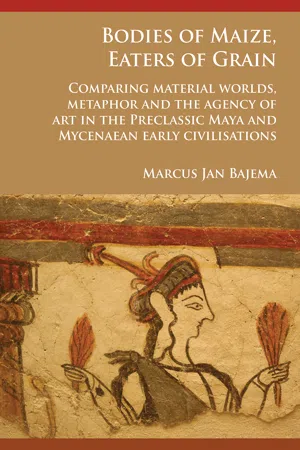
Bodies of Maize, Eaters of Grain: Comparing material worlds, metaphor and the agency of art in the Preclassic Maya and Mycenaean early civilisations
- 360 pages
- English
- PDF
- Available on iOS & Android
Bodies of Maize, Eaters of Grain: Comparing material worlds, metaphor and the agency of art in the Preclassic Maya and Mycenaean early civilisations
About this book
Bodies of Maize, Eaters of Grain provides a comparative study of the earliest urban civilisations of the Maya lowlands and the Greek mainland. It builds upon earlier comparative studies by Gordon Childe, Robert Adams and Bruce Trigger, extending their work into new directions. Specifically, the focus lies on the art styles of the Late Preclassic lowland Maya and Mycenaean Greece. The approach used here seeks to combine more traditional iconographic approaches with more recent models on metaphor and the social agency of things. Comparing Maya and Mycenaean art styles through the three aspects of metaphor, semiotics and praxis, their differences and similarities are made clear. The book shows art to have played a more active role in the development of the earliest urban civilisations, rather than passively reflecting economic and political trends. In that way, the social role of art provides a key to understanding the relations between the different factors in the development of the two societies, as they played out at different temporal and geographical scales. To understand this, the notion of distinct Maya and Mycenaean 'material worlds', involving both materials and ideas, is proposed, with consequences for models about the earliest urban civilisations in general.
Frequently asked questions
- Essential is ideal for learners and professionals who enjoy exploring a wide range of subjects. Access the Essential Library with 800,000+ trusted titles and best-sellers across business, personal growth, and the humanities. Includes unlimited reading time and Standard Read Aloud voice.
- Complete: Perfect for advanced learners and researchers needing full, unrestricted access. Unlock 1.4M+ books across hundreds of subjects, including academic and specialized titles. The Complete Plan also includes advanced features like Premium Read Aloud and Research Assistant.
Please note we cannot support devices running on iOS 13 and Android 7 or earlier. Learn more about using the app.
Information
Table of contents
- Cover
- Copyright Page
- Contents Page
- List of Figures
- Table 1.1: Overview of chapters.
- Figure 1: Levels of archaeological theory
- firstHeading